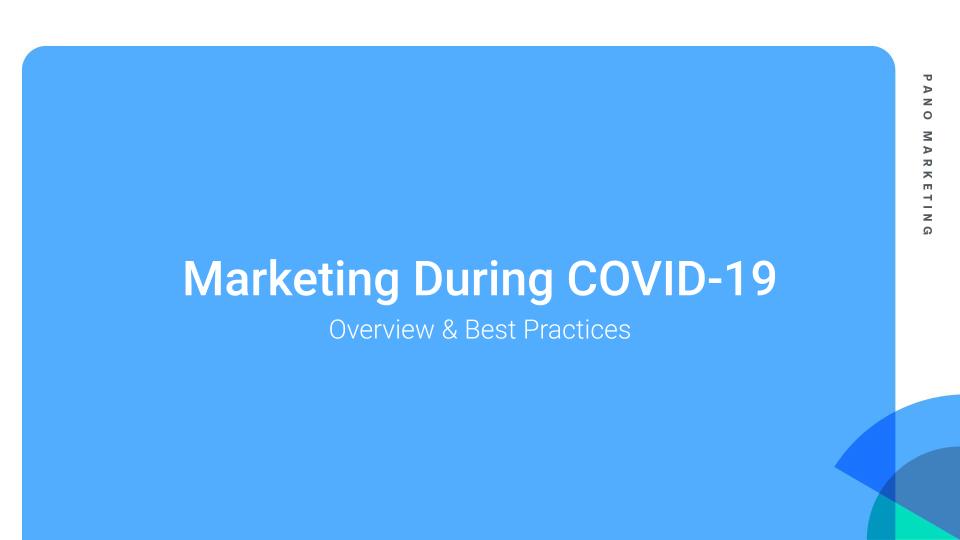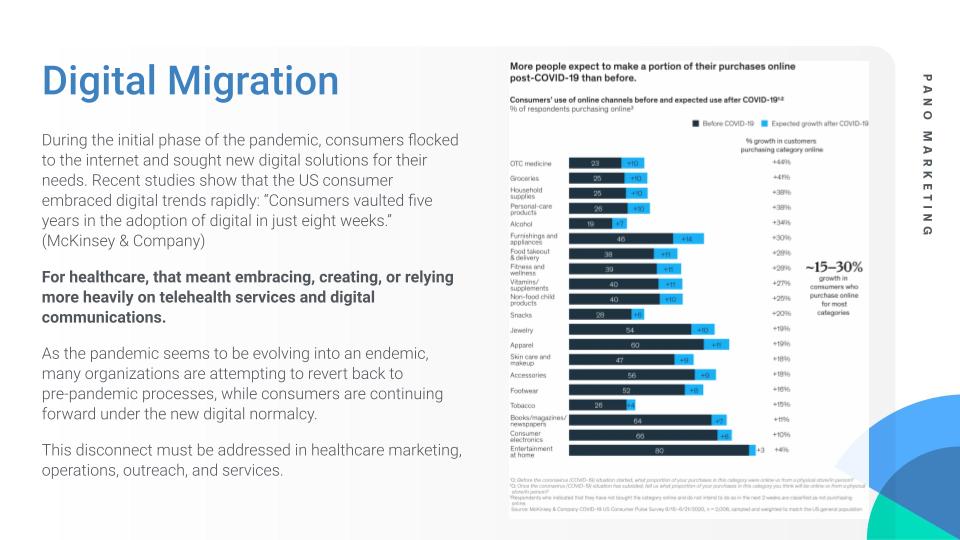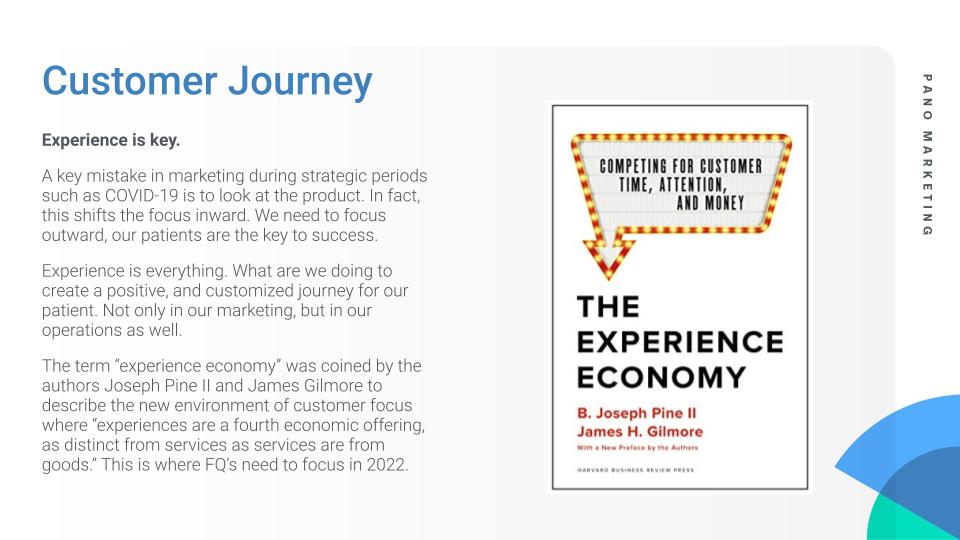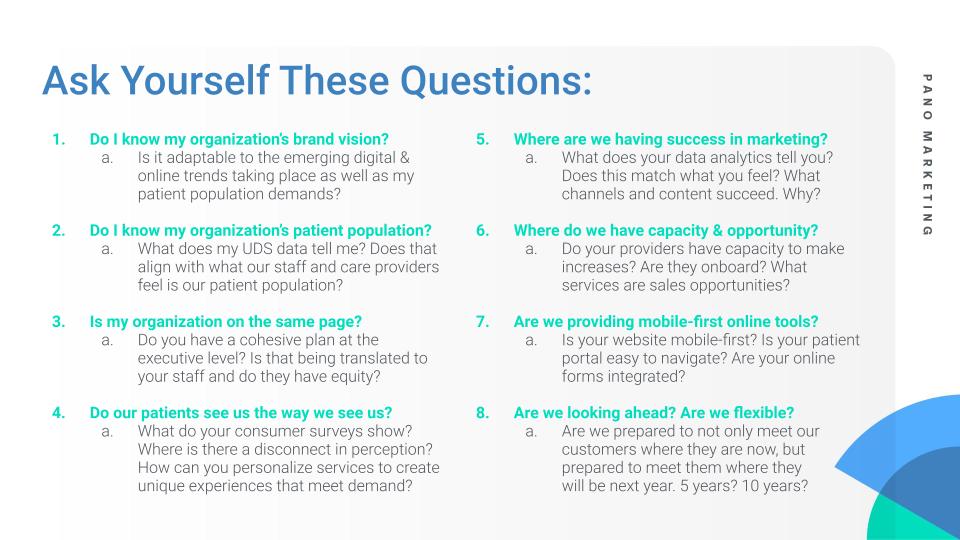Recently, our President (Ryan Gates) hosted an online roundtable presentation for Community Care Network of Kansas, the state’s primary care association that oversees the network of health centers and community-based clinics with a common goal of providing high-quality healthcare that is accessible to all Kansans. The goal of the roundtable was to provide insight, tips, and direction to community health centers as 2022 began — an interesting time with COVID-19 still affecting our daily lives while showing glimpses of evolving into an endemic instead of a pandemic. Today, we share some of those thoughts here as well in hopes that it can help more health organizations make strategic plans for the future.

Consumer Behaviors: How The Pandemic Affected Engagement & Experiences
During the initial phase of the COVID-19 pandemic, consumers flocked to the internet and sought new digital solutions for their needs. Recent studies show that the US consumer embraced digital trends rapidly: “Consumers vaulted five years in the adoption of digital in just eight weeks.” (McKinsey & Company) For healthcare, that meant embracing, creating, or relying more heavily on telehealth services and digital communications.
As the pandemic seems to be evolving into an endemic, many organizations are attempting to revert back to pre-pandemic processes, while consumers are continuing forward under the new digital normalcy. This disconnect must be addressed in healthcare marketing, operations, outreach, and services. 15% – 25% of US consumers switched brands during the pandemic when they shifted to digital. Health organizations need to offer new digital solutions moving forward, or they will likely be the ones patients are shifting away from.
Teledoc Health, one of the largest telehealth providers in the US, saw an increase of profit 3X from Q3 2019 to Q1 2020. This shift to telemedicine echos what we are seeing across all industries during the pandemic: Consumer confidence in e-services is on the rise.
However, other than groceries and at-home entertainment, all consumer categories decreased in 2020 — including health services and OTC medications. Demand for health services decreased for items like annual checkups, routine dental care, and other non-primary health services. Meanwhile, demand increased for health services related to COVID-19. With ARPA funding, many organizations met the COVID-19 demand but failed to supply solutions for the non-primary care services.
Lastly, consumers are becoming more and more invested in brands that have positive social values. While healthcare organizations, especially FQHCs, are brands that serve the community for good — not all perceptions were good during the pandemic.
- Some consumers saw ARPA funds as organizations praying on their communities.
- Scheduling and booking was a nightmare for many health organizations, resulting in poor brand perception from loyal consumers.
- COVID misinformation led some consumers to see health organizations as “part of the problem” instead of “part of the solution.”
- Partnerships waned during COVID-19, leaving many brands to tell their story alone.
- Many health organizations used CDC images instead of their own, creating branding conflicts.
The foundation to understanding consumer behavior during the pandemic and what it will mean for the future of health organizations is this: The consumer is more digitally adept than you may realize, patients are more apt to switch brands in a digital setting, and the patient values experience as much as — or more than — the product. We are not selling medical, dental, and behavioral health products…we are selling experiences.

The COVID-19 Marketing Playbook
In healthcare, we often have specific goals tied to funding, outreach, UDS, and other factors. These are a great place to start developing the foundation of marketing strategies. The 3 core values at Pano for developing a healthcare marketing plan are:
- Strategy-First
- Data-Informed
- Results-Driven
1. Strategies Come First
There is a simple statement that is a core value at Pano Marketing: Strategies come before tactics.
Too often healthcare organizations play “whack-a-mole,” reacting to what is in front of them without a concrete strategy for desired results. It is imperative that health organizations understand their data (use UDS data if available) and create strategies that support their outreach and community health goals. This includes understanding things like:
- Payor Mix
- Customer Demographics
- Community Demographics
- Financial Projections
- Potential Grants
2. Be Data-Driven
We need to be more data-driven. Understanding your data and how it relates to your strategies is imperative. Goals like “Increasing patient encounters” or “Increase community outreach” are vanity metrics…they don’t mean anything without metric goals.
If your uninsured population is 60% and your Medicaid/CHIP is 15%, you likely want to set strategic goals around increasing Medicaid/CHIP encounters specifically. Will you shift it to 20% uninsured and 45% Medicaid/CHIP in one year? No. That is unrealistic. So, how do we eat an elephant? One bite at a time.
3. Experience Is The Product
A key mistake in marketing during strategic periods such as COVID-19 is to look at the product. In fact, this shifts the focus inward. We need to focus outward, our patients are the key to success. Experience is everything. What are we doing to create a positive and customized journey for our patients? Not only in our marketing, but in our operations as well.
The term “experience economy” was coined by the authors Joseph Pine II and James Gilmore to describe the new environment of customer focus where “experiences are a fourth economic offering, as distinct from services as services are from goods.” This is where FQ’s need to focus in 2022.
4. Customer Journey & UX
We need to create custom, personalized experiences for patients across all channels through UXD (User Experience Design). If all your touchpoints and channels are saying the same thing, why would your customers interact with you in multiple places? We know customers have shifted to digital, what are you offering in the digital space that meets them where they are and drives a positive customer journey?
Hub & Spoke digital tools can encourage engagement and create opportunities for lead generation. Data from Pano’s client research has shown that over 70% of FQHC patients use their cell phone as their primary connection to the internet — if your tools and content are not mobile-first, you’re not meeting your customers where they are.
As well, many organizations created content this year for health organizations to use. CDC, State of Kansas, etc. These are great! However, they are not your brand. Don’t create brand confusion by only using these tools or sending patients somewhere online that is not your site. Sticking with Hub & Spoke: Create branded content on your website. You can have some content here from partners like the ones above). Now share this content across your channels with CTAs and links that drive engagement back into your website where there are CTAs to trackable actions.
5. Measure & Adjust
If you don’t know where you are going, any road will take you there.
This comes back to our strategy & goals. Without measuring, we don’t know if we have reached our goals. This is why we need time-bound metrics.
If things performed well, we can look at repeating, increasing, and/or getting more aggressive.
If things didn’t perform well, don’t keep doing it. Adjust. Update creative. Change channels. The definition of insanity is doing the same thing twice and expecting a different result.
Engage your financial team to measure ROI and assess how it relates to your budget.

Current Marketing Suggestions: For the Pandemic & Post-Pandemic Scenarios
We can see the digital migration in our consumer behavior research. We know the importance of developing strategies before tactics. We have the user experience in mind and are prepared to meet them where they are. What now? When working with Pano, this is likely where we dive deeper into a SWOT Analysis, establish your USP, and create a strategic marketing plan. Here are some tips any health organization can do to improve their marketing during COVID-19 and prepare themselves for a post-pandemic audience.
1. Ask Yourselves These 8 Questions:
- Do I know my organization’s brand vision?
Is it adaptable to the emerging digital & online trends taking place as well as my patient population demands? - Do I know my organization’s patient population?
What does my UDS data tell me? Does that align with what our staff and care providers feel is our patient population? - Is my organization on the same page?
Do you have a cohesive plan at the executive level? Is that being translated to your staff and do they have equity? - Do our patients see us the way we see us?
What do your consumer surveys show? Where is there a disconnect in perception? How can you personalize services to create unique experiences that meet demand? - Where are we having success in marketing?
What does your data analytics tell you? Does this match what you feel? What channels and content succeed. Why? - Where do we have capacity & opportunity?
Do your providers have capacity to make increases? Are they onboard? What services are sales opportunities? - Are we providing mobile-first online tools?
Is your website mobile-first? Is your patient portal easy to navigate? Are your online forms integrated? - Are we looking ahead? Are we flexible?
Are we prepared to not only meet our customers where they are now, but prepared to meet them where they will be next year. 5 years? 10 years?
2. Focus on Your Website
Your website will likely be the first interaction you will have with a patient as they go through the rational decision-making process of establishing a need and identifying a solution — is your website a good first impression? Your website needs to be:
- Mobile-First
- Responsive
- User-Friendly
- Hub & Spoke
- HIPAA Compliant
- Integrated with your EMR
- Integrated with your forms
- Integrated with your Patient Portal
- Integrated with Telehealth Services
- SEO Heavy (Search Engine Optimization)
Make sure you have Google Analytics setup and installed so you can track metrics. If you need help with your current website or are interested in a new website built with UX, branding, and integrations in mind — contact Pano today.
3. Conduct UX Strategic Planning
User Experience (UX) is a users’ perspective, thoughts, and feelings when using a product. User Experience Design (UXD) is the process of creating digital products that improve the users’ satisfaction and loyalty when interacting with a product. This is done by focussing on:
- Utility
- Ease of Use
- Enjoyment
Conduct a strategic planning session to look specifically at your UX and UXD. How is your check-in process? How well do you communicate with patients? What do you do after a visit to promote loyalty?
- Understand
- Research
- Analyze
- Design
- Implement
- Evaluate
It is a best practice to work with a UX team when doing UX Strategic Planning. If you need help or would like to inquire about UXD services, please contact Pano today.
4. Audit, Update, and Launch Social Media Channels
If you are not using a social media channel currently and don’t have a specific plan on how to use it to achieve goals…don’t set it up. A defunct or abandoned social media account says more than NOT having an account at all A defunct or abandoned account says “we are lazy and don’t care anymore.” Not having an account on a platform says, “We do not use this platform.” The latter is better.
Make sure you have filled out all the required sections on Facebook and LinkedIn — Twitter and Instagram require less information — and created ways for your patients and customers to interact and engage with you. Ensure all profile and cover images are in the correct dimensions so they load correctly across all devices. Remember…our customers are predominantly mobile. Matching information from your website to channels like Facebook is also good for SEO.
Setup Google My Business so you can manage your Google listing on search and map results. Add pictures of what the experience will be like when a patient comes to your organization — these are very important during the evaluation and comparison periods of consumer behavior in the marketing funnel.
Make all of your social channels unique. The easiest (and often cheapest) way healthcare organizations can communicate with customers is through social media. Make these channels unique from each other and other channels.
Look at how your patients interact with you across all your digital channels. Some suggestions:
- Facebook is a great place to interact with current patients and provide information and updates.
- Make sure Facebook Messenger is activated and create automated responses to common questions.
- Twitter is a great place for lead generation and speaking to a larger community audience.
- LinkedIn is a great place to post job openings, HR news, and business news.
- Instagram & TikTok are places for creating content that is interactive and fun. Be visual!
Lastly, focus on creating larger amounts of engaging content. In the debate around quality vs quantity when it comes to content, quantity is (unfortunately) becoming more important. Be first. Be fast. Be frequent.
As you create content on social media and other platforms, you will begin to see what drives the highest engagement and actions. Mixing it up is key, but the king of content has movement — that means video:
- Social media users have become savvy content consumers and are desensitized to much content. Basically, scroll, scroll, scroll.
- On average, video drives 2X in clicks over pictures, 30% higher conversions, and 2X in CTR.
- Use subtitles — 85% of video content on Facebook is consumed without sound.
- However, images are back on the rise as some users are becoming desensitized to videos. You need a mix.
- Target…don’t boost. Boosting is shouting into a crowd. Targeting is speaking to a group.
If you need help setting up your social media channels or managing your social media channels, Pano Marketing can help. Our outsourced marketing department model makes it easy to outsource your digital marketing to a team of industry professionals for a fraction of the cost. Contact us today to learn more.
5. Use Your Data, Then Measure & Adjust
Look at your patient data or UDS reports. Compare your 2021 data or UDS report for the past 4 years to see if there are any trends you need to be aware of. Look specifically at the following data:
- Payor Mix by Insurance Status
- Average Age (by Gender)
- Gender Ratio
- Average Household Income
- Patient Count by Ethnicity
- Patient Count by Race
- Patient Count by Location
Using this information, create goals and strategies as part of your strategic marketing planning. Your data can inform you of the need, goal, path, and measurement.
Your patient data should have both email and cell phone information along with a disclaimer for opting into advertising (or opting out). Email newsletters are a great way to interact with current patients about upcoming events and news. However, the average email open rate is 20% while the average text message open rate is 98%. Most telehealth platforms not only can send text message reminders for appointments, but they can also send text blasts for marketing materials. Add a link to your text that drives your patients to a blog post or landing page on your site with a strong CTA — the text is merely the teaser. Remember: Hub & Spoke is where it’s at!
6. Create Profiles for Yourself and Customers
Instead of envisioning a group of people, create a person to represent a group. Based on your data discoveries, create patient groups to help you understand who you are marketing to. Then, create a profile of a fake person to represent those groups. Give them a name, a backstory, and list the things like to do.
Now, when you create strategies and tactics, you can envision speaking to these specific people instead of a larger group. “How would Carol respond to this ad?” “Would John find this interesting?”
Similarly, ask yourself “What does my brand sound like?”
Much like with patient profiles, it helps to create a fictional person who is the literal voice of your brand. Create this person just like you did with your customer profiles, with a backstory. One of Pano’s clients’ brand voice is a woman named “Shelly.”
Shelly used to work for a large corporation and knows her way around an executive office. However, she hated that life and now works for herself. She’s white. She’s in her late 50’s now. She likes to wear jean shorts, she smokes (and has a smoker’s rasp), takes her Jeep rock-crawling on weekends, and if you get a drink in her she’ll tell you EXACTLY how she feels about you or the world. She’s professional in her work life…but behind that is a country girl ready to swear like a sailor and howl at the moon!
7. Get Your Staff Invested
If your staff and providers don’t know what you are doing — or don’t like it — there’s no point pushing it.
The #1 thing I hear from clients is they want to increase their patient population and increase patient encounters. Great! Where? If an increase in patient encounters in medical will stress the medical staff and create overbooking, that isn’t helping. Maybe dental needs some love. Maybe there’s an opportunity specifically in prenatal?
You have to get your providers involved. Especially during COVID-19. Staffs are stressed to their limits! Even if something is a positive gain, staff may perceive it as a negative if they don’t feel they have equity in the process right now. Reduce stress where there is stress, increase encounters where there is opportunity.
It’s all about capacity!
8. When in Doubt…Outsource
Many FQs and health organizations simply do not have the resources within their marketing department to properly execute marketing strategies.
When you ask someone to juggle multiple plates, they are going to start dropping plates. Instead of being able to effectively manage something they are really great at, they ineffectually manage everything. They are spread thin.
When you outsource your marketing department — or part of your marketing department — you are placing a team of professionals to manage all those plates. Each plate gets full attention. There’s room for more plates.
Pano Marketing offers outsourced marketing department services that give you access to a full team of professionals for less than the cost of one full-time employee. Visit our homepage to learn more and see how we can help you outsource your marketing for less than the cost of one FTE.

Outsourced Marketing Departments: Turn your Army of One into a General of Many
Marketing is an essential part of every growing business. It’s how you represent your brand, attract new customers, and retain the customers you have. It’s an integral part of your operations, and when done right, the key source to your continued growth.
Many growing businesses have a “Jack of all trades” individual. Someone who understands branding, social media, production, and the nuances of your industry. They are your marketing Swiss Army Knife. But you wouldn’t use a Swiss Army Knife to carve your Thanksgiving turkey, that’s not what it is designed to do.
The rest of the “Jack of all trades” quote is, “Master of none.” Outsourced marketing gives you a Master of all.
Outsourcing your marketing to Pano turns your Swiss Army Knife into a complete Ginsu set of knives. You get a group of highly-specialized teams with vast experience in specific fields for a fraction of the cost of one full-time employee.
Our marketing team is composed of experts in their fields with backgrounds across multiple industries including retail, automotive, healthcare, franchising, corporate, start-up, nonprofit, and more. By decentralizing our office, we have reduced overhead to allow us to provide these services at a fraction of the cost. Most importantly, the outsourced marketing subscription model gives you the full power of this team for a flat monthly rate less than the cost of one full-time employee.

